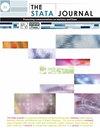xtnumfacc:一组用于时间序列和面板数据模型中公共因子数量的估计器
IF 3.2
2区 数学
Q1 SOCIAL SCIENCES, MATHEMATICAL METHODS
引用次数: 1
摘要
在本文中,我们引入了一个新的社区贡献的命令xtnumfacc,用于估计时间序列和面板数据集中的共同因子数量,使用了Bai和Ng (2002, Econometrica 70: 191-221), Ahn和Horenstein (2013, Econometrica 81: 1203-1227), Onatski (2010, Review of Economics and Statistics 92: 1004-1016)和Gagliardini, Ossola, and Scaillet (2019, Journal of Econometrics 212: 503-521)的方法。共同因素通常是不可观察或不可观察的。在时间序列中,它们影响所有预测因子,而在面板数据模型中,它们在不同程度上影响所有截面单位。例如来自油价、通货膨胀或需求或供给冲击的冲击。关于因素数量的知识是多种计量经济学估计方法的关键,如Pesaran (2006, Econometrica 74: 967-1012), Bai (2009, Econometrica 77: 1229-1279), Norkute等人(2021,Journal of Econometrica 220: 416-446), Kripfganz和Sarafidis (2021, Stata Journal 21: 659-686)。本文讨论了共10种估算公因子数量的方法。基于Kapetanios, Pesaran和Reese (2021, Journal of Econometrics 221: 510-541)的例子表明,美国房价受到多达10个共同因素的影响。因此,当一个人拟合以房价为因变量的模型时,必须考虑因素的数量。本文章由计算机程序翻译,如有差异,请以英文原文为准。
xtnumfac: A battery of estimators for the number of common factors in time series and panel-data models
In this article, we introduce a new community-contributed command, xtnumfac, for estimating the number of common factors in time-series and panel datasets using the methods of Bai and Ng (2002, Econometrica 70: 191–221), Ahn and Horenstein (2013, Econometrica 81: 1203–1227), Onatski (2010, Review of Economics and Statistics 92: 1004–1016), and Gagliardini, Ossola, and Scaillet (2019, Journal of Econometrics 212: 503–521). Common factors are usually unobserved or unobservable. In time series, they influence all predictors, while in paneldata models, they influence all cross-sectional units at different degrees. Examples are shocks from oil prices, inflation, or demand or supply shocks. Knowledge about the number of factors is key for multiple econometric estimation methods, such as Pesaran (2006, Econometrica 74: 967–1012), Bai (2009, Econometrica 77: 1229–1279), Norkute et al. (2021, Journal of Econometrics 220: 416–446), and Kripfganz and Sarafidis (2021, Stata Journal 21: 659–686). This article discusses a total of 10 methods to estimate the number of common factors. Examples based on Kapetanios, Pesaran, and Reese (2021, Journal of Econometrics 221: 510–541) show that U.S. house prices are exposed to up to 10 common factors. Therefore, when one fits models with house prices as a dependent variable, the number of factors must be considered.
求助全文
通过发布文献求助,成功后即可免费获取论文全文。
去求助
来源期刊

Stata Journal
数学-统计学与概率论
CiteScore
7.80
自引率
4.20%
发文量
44
审稿时长
>12 weeks
期刊介绍:
The Stata Journal is a quarterly publication containing articles about statistics, data analysis, teaching methods, and effective use of Stata''s language. The Stata Journal publishes reviewed papers together with shorter notes and comments, regular columns, book reviews, and other material of interest to researchers applying statistics in a variety of disciplines.
 求助内容:
求助内容: 应助结果提醒方式:
应助结果提醒方式:


